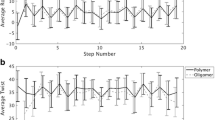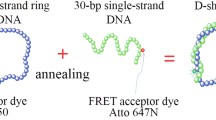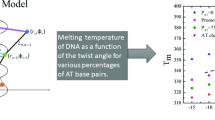Abstract
Understanding unwinding and melting of double helical DNA is very important to characterize role of DNA in replication, transcription, translation etc. Sequence dependent melting thermodynamics is used extensively for detecting promoter regions but melting studies are generally done for short oligonucleotides. This study reports several molecular dynamics (MD) simulations of homopolymeric poly(dA).poly(dT) as regular oligonucleotide fragments as well as its corresponding polymeric constructs with water and charge-neutralizing counterions at different temperatures ranging from 300 to 400 K. We have eliminated the end-effect or terminal peeling propensity by employing MD simulation of DNA oligonucleotides in such a manner that gives rise to properties of polymeric DNA of infinite length. The dynamic properties such as basepairing and stacking geometry, groove width, backbone conformational parameters, bending, distribution of counter ions and number of hydrogen bonds of oligomeric and polymeric constructs of poly(dA).poly(dT) have been analyzed. The oligomer shows terminal fraying or peeling effect at temperatures above 340 K. The polymer shows partial melting at elevated temperatures although complete denaturations of basepairs do not take place. The analysis of cross strand hydrogen bonds shows that the number of N–H···O hydrogen bonds increases with increase in temperature while C–H···O hydrogen bond frequencies decrease with temperature. Restructuring of counterions in the minor groove with temperature appear as initiation of melting in duplex structures.








Similar content being viewed by others
References
Kannan S, Zacharias M (2009) Simulation of DNA double-strand dissociation and formation during replica-exchange molecular dynamics simulations. Phys Chem Chem Phys 11(45):10589–10595
Zeng Y, Zocchi G (2006) Mismatches and bubbles in DNA. Biophys J 90(12):4522–4529
SantaLucia J Jr (1998) A unified view of polymer, dumbbell, and oligonucleotide DNA nearest-neighbor thermodynamics. Proc Natl Acad Sci USA 95(4):1460–1465
Khandelwal G, Jayaram B (2010) A phenomenological model for predicting melting temperatures of DNA sequences. PLoS One 5(8):12433. doi:10.1371/journal.pone.0012433
Rangannan V, Bansal M (2011) PromBase: a web resource for various genomic features and predicted promoters in prokaryotic genomes. BMC Res Notes 4:257
Seibel GL, Singh UC, Kollman PA (1985) A molecular-dynamics simulation of double-helical B-DNA including counterions and water. Proc Natl Acad Sci USA 82(19):6537–6540
Leach A (2001) Molecular modelling: principles and applications. Pearson Education Limited, Dorchester, UK
Perez A, Luque FJ, Orozco M (2007) Dynamics of B-DNA on the microsecond time scale. J Am Chem Soc 129(47):14739–14745
Beveridge DL, Barreiro G, Byun KS, Case DA, Cheatham TE, Dixit SB, Giudice E, Lankas F, Lavery R, Maddocks JH, Osman R, Seibert E, Sklenar H, Stoll G, Thayer KM, Varnai P, Young MA (2004) Molecular dynamics simulations of the 136 unique tetranucleotide sequences of DNA oligonucleotides. I. Research design and results on d(C(p)G) steps. Biophys J 87(6):3799–3813
Dixit SB, Beveridge DL, Case DA, Cheatham TE, Giudice E, Lankas F, Lavery R, Maddocks JH, Osman R, Sklenar H, Thayer KM, Varnai P (2005) Molecular dynamics simulations of the 136 unique tetranucleotide sequences of DNA oligonucleotides. II: sequence context effects on the dynamical structures of the 10 unique dinucleotide steps. Biophys J 89(6):3721–3740
Arauzo-Bravo MJ, Fujii S, Kono H, Ahmad S, Sarai A (2005) Sequence-dependent conformational energy of DNA derived from molecular dynamics simulations: toward understanding the indirect readout mechanism in protein-DNA recognition. J Am Chem Soc 127(46):16074–16089
Fujii S, Kono H, Takenaka S, Go N, Sarai A (2007) Sequence-dependent DNA deformability studied using molecular dynamics simulations. Nucleic Acids Res 35(18):6063–6074
Drsata T, Perez A, Orozco M, Morozov AV, Sponer J, Lankas F (2013) Structure, stiffness and substates of the Dickerson–Drew dodecamer. J Chem Theory Comput 9(1):707–721
Drukker K, Schatz GC (2000) A model for simulating dynamics of DNA denaturation. J Phys Chem B 104(26):6108–6111
Linak MC, Dorfman KD (2010) Analysis of a DNA simulation model through hairpin melting experiments. J Chem Phys 133(12):125101. doi:10.1063/1.3480685
Perez A, Orozco M (2010) Real-time atomistic description of DNA unfolding. Angew Chem Int Ed Engl 49(28):4805–4808
Izanloo C, Parsafar GA, Abroshan H, Akbarzadeh H (2011) Denaturation of Drew–Dickerson DNA in a high salt concentration medium: molecular dynamics simulations. J Comput Chem 32(16):3354–3361
Bueren-Calabuig JA, Giraudon C, Galmarini CM, Egly JM, Gago F (2011) Temperature-induced melting of double-stranded DNA in the absence and presence of covalently bonded antitumour drugs: insight from molecular dynamics simulations. Nucleic Acids Res 39(18):8248–8257
Wong KY, Pettitt BM (2008) The pathway of oligomeric DNA melting investigated by molecular dynamics simulations. Biophys J 95(12):5618–5626
Mukherjee S, Bhattacharyya D (2013) Influence of divalent magnesium ion on DNA: molecular dynamics simulation studies. J Biomol Struct Dyn 31(8):896–912
Kundu S, Mukherjee S, Bhattacharyya D (2012) Effect of temperature on DNA double helix: an insight from molecular dynamics simulation. J Biosci 37(3):445–455
Bevan DR, Li LP, Pedersen LG, Darden TA (2000) Molecular dynamics simulations of the d(CCAACGTTGG)(2) decamer: influence of the crystal environment. Biophys J 78(2):668–682
Bhattacharyya D, Kundu S, Thakur AR, Majumdar R (1999) Sequence directed flexibility of DNA and the role of cross-strand hydrogen bonds. J Biomol Struct Dyn 17(2):289–300
Kunkel GR, Martinson HG (1981) Nucleosomes will not form on double-stranded RNA or over poly(dA).poly(dT) tracts in recombinant DNA. Nucleic Acids Res 9(24):6869–6888
Rhodes D (1979) Nucleosome cores reconstituted from poly(dA-dT) and the octamer of histones. Nucleic Acids Res 6(5):1805–1816
Pilet J, Blicharski J, Brahms J (1975) Conformations and structural transitions in polydeoxynucleotides. Biochemistry 14(9):1869–1876
Alexeev DG, Lipanov AA, Skuratovskii IY (1987) Poly(dA). poly(dT) is a B-type double helix with a distinctively narrow minor groove. Nature 325(6107):821–823
Arnott S, Selsing E (1974) Structures for polynucleotide complexes poly(dA). poly(dT) and poly(dT).poly(dA).poly(dT). J Mol Biol 88(2):509–521
Park HS, Arnott S, Chandrasekaran R, Millane RP, Campagnari F (1987) Structure of the alpha-form of poly[d(A)].poly[d(T)] and related polynucleotide duplexes. J Mol Biol 197(3):513–523
Arnott S, Chandrasekaran R, Hall IH, Puigjaner LC (1983) Heteronomous DNA. Nucleic Acids Res 11(12):4141–4155
Bolshoy A, McNamara P, Harrington RE, Trifonov EN (1991) Curved DNA without A–A: experimental estimation of all 16 DNA wedge angles. Proc Natl Acad Sci USA 88(6):2312–2316
Crothers DM, Haran TE, Nadeau JG (1990) Intrinsically bent DNA. J Biol Chem 265(13):7093–7096
Premilat S, Albiser G (1997) X-ray fibre diffraction study of an elevated temperature structure of poly(dA).poly(dT). J Mol Biol 274(1):64–71
Puhl HL, Behe MJ (1995) Poly(dA)·poly(dT) forms very stable nucleosomes at higher temperatures. J Mol Biol 245(5):559–567
Chan SS, Austin RH, Mukerji I, Spiro TG (1997) Temperature-dependent ultraviolet resonance Raman spectroscopy of the premelting state of dA.dT DNA. Biophys J 72(4):1512–1520
Nelson HCM, Finch JT, Luisi BF, Klug A (1987) The structure of an oligo(dA).oligo(dT) tract and its biological implications. Nature 330(6145):221–226
Korolev N, Lyubartsev AP, Laaksonen A, Nordenskiold L (2003) A molecular dynamics simulation study of oriented DNA with polyamine and sodium counterions: diffusion and averaged binding of water and cations. Nucleic Acids Res 31(20):5971–5981
Cheng Y, Korolev N, Nordenskiold L (2006) Similarities and differences in interaction of K+ and Na+ with condensed ordered DNA. A molecular dynamics computer simulation study. Nucleic Acids Res 34(2):686–696
Dai L, Mu Y, Nordenskiold L, van der Maarel JR (2008) Molecular dynamics simulation of multivalent-ion mediated attraction between DNA molecules. Phys Rev Lett 100(11):118301
Samanta S, Mukherjee S, Chakrabarti J, Bhattacharyya D (2009) Structural properties of polymeric DNA from molecular dynamics simulations. J Chem Phys 130(11):115103. doi:10.1063/1.3078797
Mitchell JS, Laughton CA, Harris SA (2011) Atomistic simulations reveal bubbles, kinks and wrinkles in supercoiled DNA. Nucleic Acids Res 39(9):3928–3938
Saenger W (1984) Principles of nucleic acid structure. Springer, New York
Foloppe N, MacKerell AD (2000) All-atom empirical force field for nucleic acids: I. Parameter optimization based on small molecule and condensed phase macromolecular target data. J Comput Chem 21(2):86–104
Perez A, Marchan I, Svozil D, Sponer J, Cheatham TE, Laughton CA, Orozco M (2007) Refinement of the AMBER force field for nucleic acids: improving the description of alpha/gamma conformers. Biophys J 92(11):3817–3829
Chandrasekaran R, Arnott S (1996) The structure of B-DNA in oriented fibers. J Biomol Struct Dyn 13(6):1015–1027
MacKerell AD, Banavali NK (2000) All-atom empirical force field for nucleic acids: II. Application to molecular dynamics simulations of DNA and RNA in solution. J Comput Chem 21(2):105–120
Kale L, Skeel R, Bhandarkar M, Brunner R, Gursoy A, Krawetz N, Phillips J, Shinozaki A, Varadarajan K, Schulten K (1999) NAMD2: greater scalability for parallel molecular dynamics. J Comput Phys 151(1):283–312
Nelson M, Humphrey W, Kufrin R, Gursoy A, Dalke A, Kale L, Skeel R, Schulten K (1995) MDScope—a visual computing environment for structural biology. Comput Phys Commun 91(1–3):111–133
Brooks BR, Bruccoleri RE, Olafson BD, States DJ, Swaminathan S, Karplus M (1983) CHARMM—a program for macromolecular energy, minimization, and dynamics calculations. J Comput Chem 4(2):187–217
Darden T, York D, Pedersen L (1993) Particle mesh Ewald—an N.Log(N) method for Ewald sums in large systems. J Chem Phys 98(12):10089–10092
Jorgensen WL, Chandrasekhar J, Madura JD, Impey RW, Klein ML (1983) Comparison of simple potential functions for simulating liquid water. J Chem Phys 79(2):926–935
Jorgensen WL, Jenson C (1998) Temperature dependence of TIP3P, SPC, and TIP4P water from NPT Monte Carlo simulations: seeking temperatures of maximum density. J Comput Chem 19(10):1179–1186
Izanloo C, Parsafar GA, Abroshan H, Akbarzade H (2011) Calculation of melting temperature and transition curve for Dickerson DNA dodecamer on the basis of configurational entropy, hydrogen bonding energy, and heat capacity: a molecular dynamics simulation study. J Iran Chem Soc 8(3):708–716
Smiatek J, Liu D, Heuer A (2012) High temperature unfolding simulations of a single-stranded DNA i-motif. Curr Phys Chem 2(1):115–123
Qamhieh K, Wong KY, Lynch GC, Pettitt BM (2009) The melting mechanism of DNA tethered to a surface. Int J Numer Anal Model 6(3):474–488
Priyakumar UD, Harika G, Suresh G (2010) Molecular simulations on the thermal stabilization of DNA by hyperthermophilic chromatin protein Sac7d, and associated conformational transitions. J Phys Chem B 114(49):16548–16557
Hoover WG (1985) Canonical dynamics—equilibrium phase-space distributions. Phys Rev A 31(3):1695–1697
Feller SE, Zhang YH, Pastor RW, Brooks BR (1995) Constant-pressure molecular-dynamics simulation—the Langevin piston method. J Chem Phys 103(11):4613–4621
Halder S, Bhattacharyya D (2010) Structural stability of tandemly occurring noncanonical basepairs within double helical fragments: molecular dynamics studies of functional RNA. J Phys Chem B 114(44):14028–14040
Bansal M, Bhattacharyya D, Ravi B (1995) NUPARM and NUCGEN—software for analysis and generation of sequence-dependent nucleic-acid structures. Comput Appl Biosci 11(3):281–287
Mukherjee S, Bansal M, Bhattacharyya D (2006) Conformational specificity of non-canonical base pairs and higher order structures in nucleic acids: crystal structure database analysis. J Comput Aided Mol Des 20(10–11):629–645
Olson WK, Bansal M, Burley SK, Dickerson RE, Gerstein M, Harvey SC, Heinemann U, Lu XJ, Neidle S, Shakked Z, Sklenar H, Suzuki M, Tung CS, Westhof E, Wolberger C, Berman HM (2001) A standard reference frame for the description of nucleic acid base-pair geometry. J Mol Biol 313(1):229–237
Dickerson RE, Bansal M, Calladine CR, Diekman S, Hunter WN, Kennard O, von Kidzing E, Lavery R, Nelson HCM, Olson WK, Saenger W, Shakked Z, Skenar H, Soumpasis DM, Tung CS, Wang AHJ, Zurkin VB (1989) Definitions and nomenclature of nucleic acid structure parameters. EMBO J 8(1):1–4
Halder S, Bhattacharyya D (2013) RNA structure and dynamics: a base pairing perspective. Prog Biophys Mol Biol 113(2):264–283
Wang JC (1979) Helical repeat of DNA in solution. Proc Natl Acad Sci USA 76(1):200–203
Bhattacharyya D, Bansal M (1989) A self-consistent formulation for analysis and generation of non-uniform DNA structures. J Biomol Struct Dyn 6(4):635–653
Kanhere A, Bansal M (2003) An assessment of three dinucleotide parameters to predict DNA curvature by quantitative comparison with experimental data. Nucleic Acids Res 31(10):2647–2658
Skjaerven L, Martinez A, Reuter N (2011) Principal component and normal mode analysis of proteins; a quantitative comparison using the GroEL subunit. Proteins 79(1):232–243
Sprous D, Zacharias W, Wood ZA, Harvey SC (1995) Dehydrating agents sharply reduce curvature in DNAs containing A tracts. Nucleic Acids Res 23(10):1816–1821
Fritsch V, Westhof E (1991) 3-Center hydrogen-bonds in DNA—molecular-dynamics of poly(dA).poly(dT). J Am Chem Soc 113(22):8271–8277
McConnell KJ, Beveridge DL (2001) Molecular dynamics simulations of B′-DNA: sequence effects on A-tract-induced bending and flexibility. J Mol Biol 314(1):23–40
Strahs D, Schlick T (2000) A-tract bending: insights into experimental structures by computational models. J Mol Biol 301(3):643–663
Hud NV, Polak M (2001) DNA-cation interactions: the major and minor grooves are flexible ionophores. Curr Opin Struct Biol 11(3):293–301
Ghosh A, Bansal M (1999) C–H⋯O hydrogen bonds in minor groove of A-tracts in DNA double helices. J Mol Biol 294(5):1149–1158
Kundu S, Roy D (2010) Structural study of carboxylesterase from hyperthermophilic bacteria Geobacillus stearothermophilus by molecular dynamics simulation. J Mol Graph Model 28(8):820–827
Sponer J, Burcl R, Hobza P (1994) Interactions between amino-groups in DNA—an ab initio study and a comparison with empirical potentials. J Biomol Struct Dyn 11(6):1357–1376
Bandyopadhyay D, Bhattacharyya D (2006) Estimation of strength in different extra Watson–Crick hydrogen bonds in DNA double helices through quantum chemical studies. Biopolymers 83(3):313–325
Mitra P, Chakraborty B, Bhattacharyya D, Basu S (2013) Excimer of 9-aminoacridine hydrochloride hydrate in confined medium: an integrated experimental and theoretical study. J Phys Chem A 117(7):1428–1438
Long H, Kudlay A, Schatz GC (2006) Molecular dynamics studies of ion distributions for DNA duplexes and DNA clusters: salt effects and connection to DNA melting. J Phys Chem B 110(6):2918–2926
Author information
Authors and Affiliations
Corresponding author
Additional information
Sanchita Mukherjee and Sangeeta Kundu have contributed equally to this work.
Electronic supplementary material
Below is the link to the electronic supplementary material.
Rights and permissions
About this article
Cite this article
Mukherjee, S., Kundu, S. & Bhattacharyya, D. Temperature effect on poly(dA).poly(dT): molecular dynamics simulation studies of polymeric and oligomeric constructs. J Comput Aided Mol Des 28, 735–749 (2014). https://doi.org/10.1007/s10822-014-9755-x
Received:
Accepted:
Published:
Issue Date:
DOI: https://doi.org/10.1007/s10822-014-9755-x




